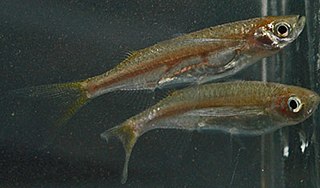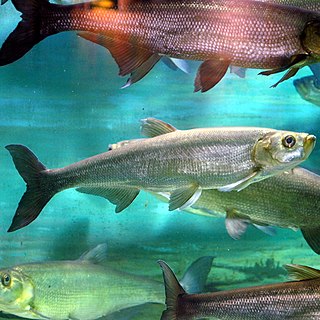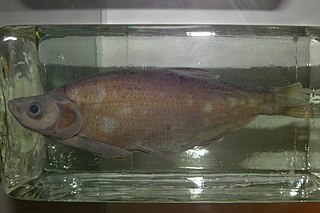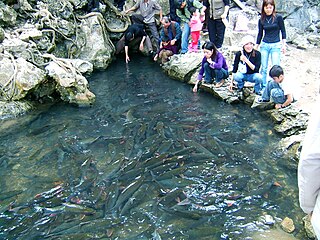
Parachela is a genus of freshwater ray-finned fish belonging to the family Xenocyprididae, the East Asian minnows or sharpbellies. These fishes are found in Asia.
Sinibrama of freshwater ray-finned fish belonging to the family Xenocyprididae, the East Asian minnows or sharpbellies. The fihses in this genus are found in southern China, Taiwan, Laos, and Vietnam. These are silvery fishes with deep, laterally compressed bodies, large eyes, and terminal mouths. They tend to grow no larger than 20 cm in standard length.

Chanodichthys is a genus of freshwater ray-finned fishes belonging to the family Xenocyprididae, the East Asian minnows or sharpbellies. The species in this genus are found in Eastern Asia. The name is derived from the Greek word chanos, meaning "abyss, mouth opened, inmensity", and the Greek word ichthys, meaning "fish". Chanodichthys is closely related to Culter and some species have been moved between these genera.

Culter is a genus of freshwater ray-finned fishes belonging to the family Xenocyprididae, the East Asian minnows or sharpbellies. The fishes in thsi genus are found in eastern Asia from Siberia to Viet Nam. The name is derived from the Latin word culter, meaning "knife". Culter is closely related to Chanodichthys and some species have been moved between these genera.
The white Amur bream is a species of freshwater ray-finned fish belonging to the family Xenocyprididae, the East Asian minnows or sharpbellies This is the only species in the monospecific genus Parabramis. It is native to eastern Asia, where found from the Amur River basin in Russia south to Ningbo and Shanghai in China. It is an important food fish, and has been introduced to regions outside its native range.

Zacco is a genus of small freshwater ray-finned fishes belonging to the family Xenocyprididae, the East Asian minnows or sharpbellies. They are found in freshwater habitats in China and northern Vietnam. The generic name Zacco derives from the Japanese Zako雑魚.

Aphyocypris is a genus of freshwater ray-finned fishes belonging to the family Xenocyprididae. This genus has eight valid species, all of which are restricted to East Asia.
Araiocypris is a monospecific genus of freshwater ray-finned fish belonging to the family Xenocyprididae, the East Asian minnows or sharpbellies. The only species in the genus is Araiocypris batodes, a very small fish endemic to Vietnam.
Atrilinea is a genus of freshwater ray-finned fishes belonging to the family Xenocyprididae. This is a small genus with three valid species, all of which are endemic to China.

Candidia is a genus of freshwater ray-finned fishes belonging to the family Xenocyprididae. This is a small genus with two valid species, all of which are endemic to Taiwan.
Elopichthys is a monospecific genus of freshwater ray-finned fish belonging to the family Xenocyprididae, the East Asian minnows or sharpbellies. The only species in the genus is Elopichthys bambusa, the yellowcheek or kanyu, a large fish that is found in freshwater habitats in eastern Asia. It ranges from the Amur River in Russia, through China to the Red and Lam Rivers in Vietnam. It prefers relatively warm waters, entirely avoiding colder highlands. It is considered an important food fish where it occurs, reaching up to 2 m in total length and 52.2 kg (115 lb) in weight.
Luciobrama is a monospecific genus of freshwater ray-finned fish belonging to the family Xenocyprididae, the East Asian minnows or sharpbellies. The only species in the genus is Luciobrama macrocephala, the long spiky-head carp, a fish that is found in China and Vietnam. It is classified as data deficient by the IUCN. It is found in rivers and lakes. Larger fish, over 30 centimetres (12 in) live nearer the bottom and the smaller specimens are found higher in the water column. They are partially migratory. It has not been recorded from four of its known spawning sites since 1988.
Metzia is a genus of freshwater ray-finned fish belonging to the family Xenocyprididae, the East Asian minnows or sharpbellies. The fishes in this genus are found in Asia. The genus is named in honor of the American ichthyologist Charles William Metz of Stanford University.

Opsariichthys is a genus of freshwater ray-finned fish belonging to the family Xenocyprididae, the East Asian minnows or sharpbellies found in freshwater habitats in Mainland China, Taiwan, Japan, Korea, and Vietnam.

Oxygaster is a genus of freshwater ray-finned fish belonging to the family Xenocyprididae, the East Asian minnows or sharpbellies. The species in this genus are found in Southeast Asia.
Paralaubuca s a genus of freshwater ray-finned fish belonging to the family Xenocyprididae, the East Asian minnows or sharpbellies. The species in this genus are found in Asia.
Pseudobrama is a monospecific genus of freshwater ray-finned fish belonging to the family Xenocyprididae, the East Asian minnows or sharpbellies. The only species in the genus is Pseudobrama simoni, a fish endemic to China. This species is found in fresh and brackish water in the Yangtze and other rivers in Eastern China.
Rasborichthys is a monospecific genus of freshwater ray-finned fish belonging to the family Xenocyprididae, the East Asian minnows or sharpbellies. The only species in the genus is Rasborichthys helfrichii a fish found on the islands of Sumatra and Borneo in Southeast Asia.
Xenocypris medius is a species of freshwater ray-finned fish belonging to the family Xenocyprididae, the East Asian minnows or sharpbellies. This fish is endemic to Taiwan.

Spinibarbichthys is a genus of freshwater ray-finned fishes belonging to the family Cyprinidae, the family which includes the carps, barbs and related fishes. The fishes in this genus are found in China and Southeast Asia.








